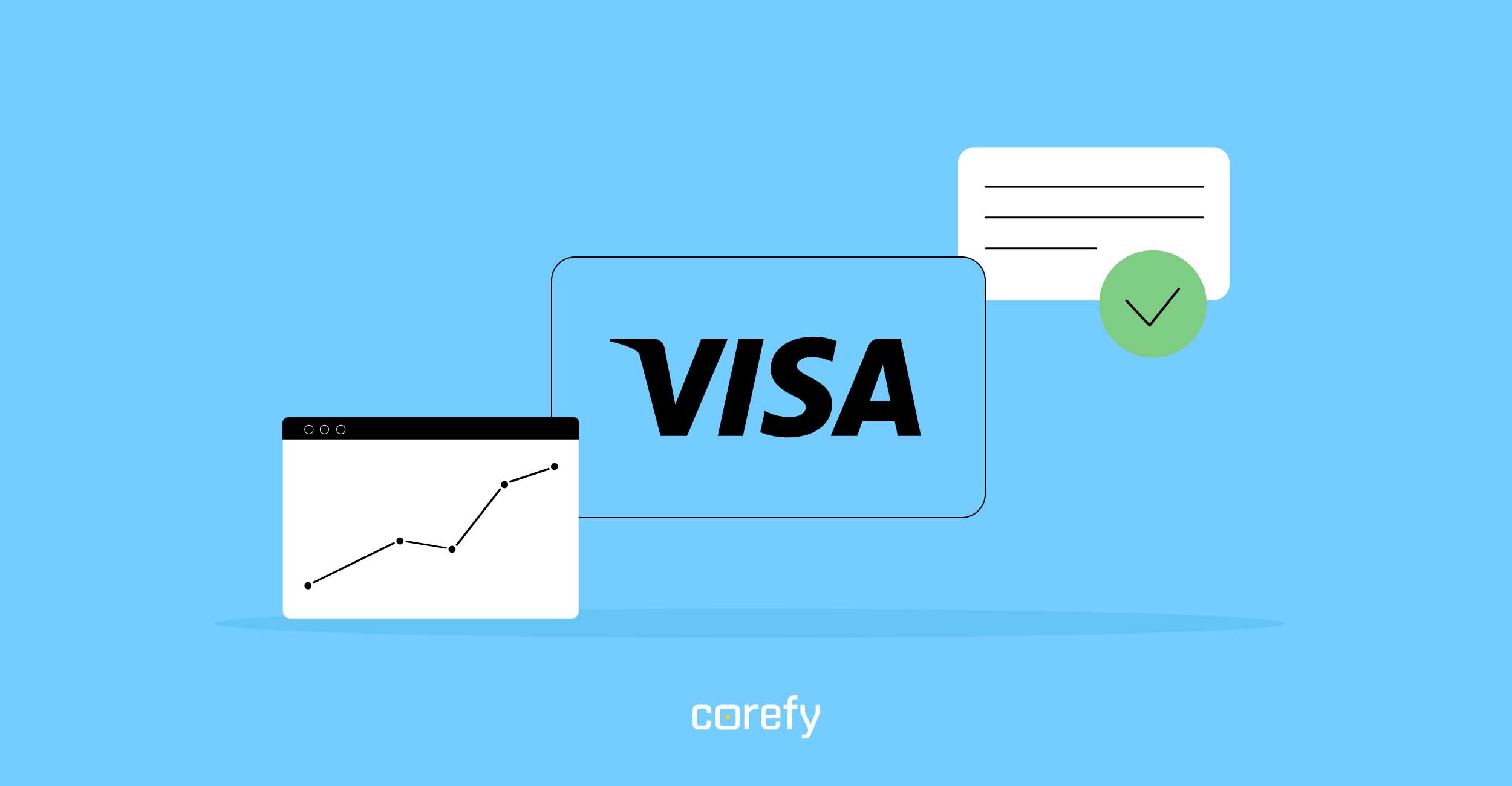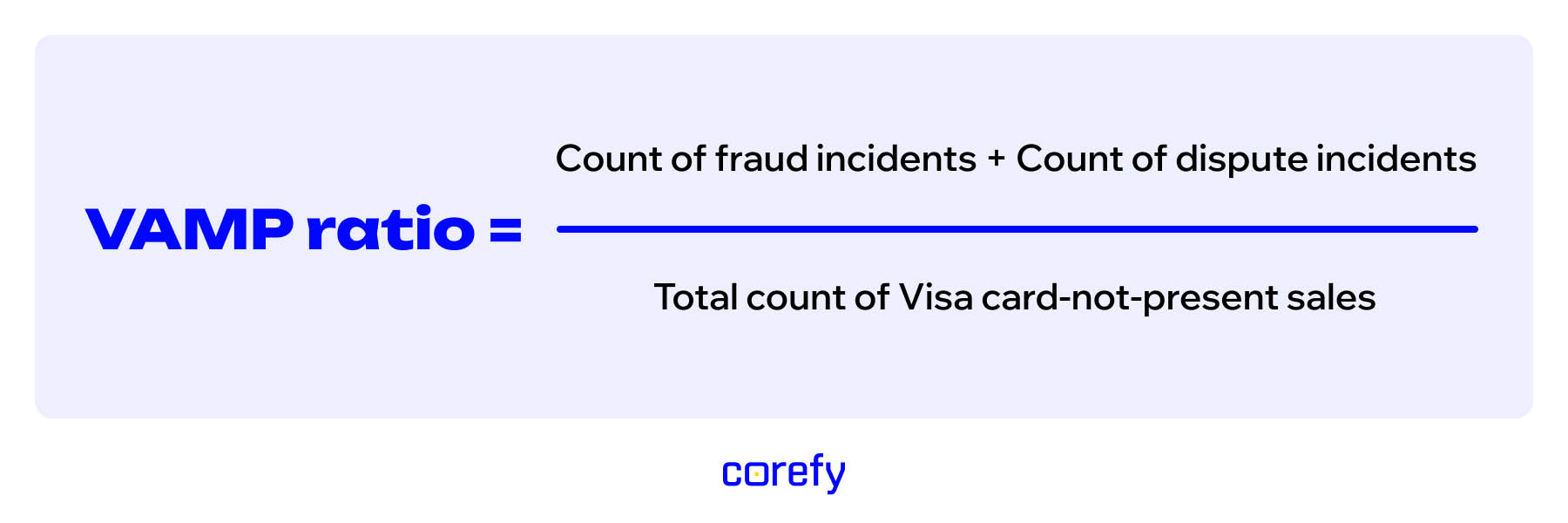Visa VAMP explained: key changes for merchants & payment businesses


In 2025, Visa launched the Visa Acquirer Monitoring Program (VAMP) – a unified global framework to tackle fraud, chargebacks, and enumeration attacks.
VAMP reshapes how performance is measured across the payments ecosystem. It directly impacts costs, compliance risk, and even acquirers' ability to maintain banking relationships.
Here’s what changed, why it matters, and how to stay compliant.
The program is already driving real change in payments, reshaping expectations for VAMP payment processing across acquirers, merchants, and PSPs. The goal is clear: make acquirers accountable for managing fraud and dispute levels in their portfolios.
A cornerstone of the Visa Acquirer Monitoring Program is its unified risk metric, the VAMP ratio, which combines fraud and dispute counts. This is a shift from prior programs that tracked fraud and chargebacks separately.
The VAMP ratio is calculated as:

Under VAMP, Visa reviews each acquirer's performance monthly. Those that cross certain thresholds are placed into one of two categories:
Merchants are not directly enrolled in VAMP, but because their fraud and dispute activity is aggregated into their acquirer’s portfolio, it can push the acquirer over Visa’s thresholds, making the acquirer liable for fines and driving them to pressure, penalise, or even terminate high-risk merchants.
For merchants, being flagged as Excessive means crossing a 1.5% threshold.
.jpg)
The news about VAMP began spreading in early 2025, as Visa launched a phased rollout to give acquirers and merchants time to adjust before enforcement. For the first six months, the program operated in an advisory mode. As of October 1, 2025, Visa transitioned VAMP into full enforcement.
Here’s a look at the changes already live and the ones you should prepare for.
| Date | Before | After |
|---|---|---|
| April 1, 2025 | Multiple legacy programs; fraud/disputes tracked separately | Launch of VAMP, single ratio, enumeration monitoring introduced |
| April–September 2025 | Advisory only; no financial penalties | Acquirers received warnings and “shadow” compliance reports |
| June 1, 2025 | Lower volume thresholds (1000 incidents) and older ratio levels (~0.3%) | Thresholds raised: 1500+ incidents required; Above Standard ≥0.5%, Excessive ≥0.7% |
| October 1, 2025 | Advisory phase, no fines | Enforcement begins for “Excessive” acquirers/merchants; $10 per incident |
| January 1, 2026 | No fees for Above Standard status | Enforcement begins for “Above Standard” acquirers; $5 per incident |
| April 1, 2026 | Excessive Merchant threshold = 2.2% in most regions | Threshold tightened globally to 1.5% |
From October 1, 2025, Visa began enforcing penalties under VAMP. This marks the first time financial consequences are systematically applied across the network – a significant shift toward active risk governance.
Fines are calculated per incident:
Visa’s Acquirer Monitoring Program reshapes responsibility across the payments ecosystem. Each stakeholder group is affected in distinct ways.
Acquirers now bear full responsibility for the fraud and dispute performance of their portfolios. With monthly monitoring based on the VAMP ratio, any breach of thresholds triggers mandatory investigation, remediation, and formal reporting within tight deadlines.
Despite the pressure, consistent low ratios bring clear rewards: stronger issuer trust, reduced losses, and potentially better treatment within the network.
Visa places liability on acquirers, but the effects cascade to merchants. Acquirers may introduce stricter requirements, increase costs, or exit high-risk relationships.
Sitting between acquirers and merchants, processors and payment facilitators must take ownership of overall performance.
The impact of VAMP on payment processors is clear: tighter portfolio oversight, faster remediation cycles, and stronger prevention against VAMP enumeration attacks.
Staying ahead of VAMP requires building proactive, data-driven defences. Here are five essential steps every acquirer, PSP, and merchant should take to avoid being flagged.
Build live dashboards at both the portfolio and merchant levels with alerts at 0.4%, 0.5%, and 0.7%. Real-time monitoring lets you investigate anomalies quickly, not after the billing cycle. This is especially critical as Visa VAMP changes lower tolerance for delays and inaction — a core element of VAMP compliance.
Use device/risk scoring, velocity rules, BIN screening, and step-up authentication flows. Strong Customer Authentication (SCA) with 3D Secure helps reduce liability and exposure. Pair this with a payment fraud prevention strategy tailored to your business model to strengthen your VAMP compliance posture.
Visa is watching VAMP enumeration attacks closely. Add velocity limits, CAPTCHA/JS challenges, and bot detection to keep automated card testing out of your fraud totals. Preventing this activity can make the difference between compliance and “Excessive” status.
Clear descriptors, transparent refund flows, and automated evidence handling help resolve disputes before they escalate. Early resolution reduces your VAMP ratio and shields you from fines. This is one of the most effective levers for maintaining VAMP compliance over time.
Segment merchants by risk profile, apply stricter thresholds to high-risk verticals, and set clear corrective Service Level Agreements (SLAs). A single outlier can still push an acquirer into violation, which is even more dangerous under Visa VAMP.
With VAMP enforcement now live, proactive monitoring and rapid response are the only safe strategy. Corefy's chargeback management service is designed with this in mind, helping businesses keep ratios under control and avoid costly penalties.

The system facilitates immediate communication between merchants and card issuers, providing clear transaction details that reduce the chances of disputes escalating. Disputes intercepted and resolved at this stage don't count toward the VAMP ratio, which makes proactive management one of the most effective compliance levers.
The result is not just reduced financial exposure, but a stronger compliance posture that supports healthier banking relationships and higher approval rates.
Visa monitors merchant activity through their acquiring banks. Each acquirer’s portfolio is reviewed monthly using the VAMP Ratio, which combines fraud and dispute counts relative to total card-not-present transactions. If a merchant’s metrics exceed defined thresholds, Visa can flag that specific merchant as “Excessive,” even if the acquirer’s overall performance is within compliance. This structure pushes acquirers to closely monitor their merchant base and take action early.
Acquirers can lower their risk by taking a proactive approach to fraud and dispute management. This includes real-time monitoring of merchant performance, implementing layered fraud prevention measures, and acting quickly on any unusual activity. Detecting and stopping VAMP enumeration attacks early is key, as they can artificially inflate incident counts. Strong communication with merchants, regular risk reviews, and early dispute resolution strategies all contribute to stronger VAMP compliance.
While merchants aren’t directly flagged under Visa’s Acquirer Monitoring Program (VAMP), their activity can trigger their acquirer to be flagged if it drives high fraud or dispute levels. If your acquirer notifies you about VAMP-related concerns, swift action is essential.
This typically involves:
Even though Visa holds acquirers accountable, merchants that drive high VAMP ratios may face stricter monitoring, additional requirements, or even termination of processing if issues aren’t resolved.
The primary trigger is exceeding the VAMP ratio thresholds – 0.5% (Above Standard) and 0.7% (Excessive) for acquirers. For merchants, thresholds currently stand at 1.5% and will tighten further in upcoming phases. High volumes of disputes, elevated fraud rates, or excessive enumeration activity can also prompt escalation. These thresholds are reviewed monthly, so consistent performance matters.
Typically, Visa grants a three-month grace period to address elevated fraud, dispute, or enumeration activity without immediate penalties.
If the acquirer successfully reduces its VAMP ratio below the set thresholds within that timeframe, they can exit the program. However, if the problem persists, Visa may extend the monitoring period and apply escalating fines or other enforcement actions.